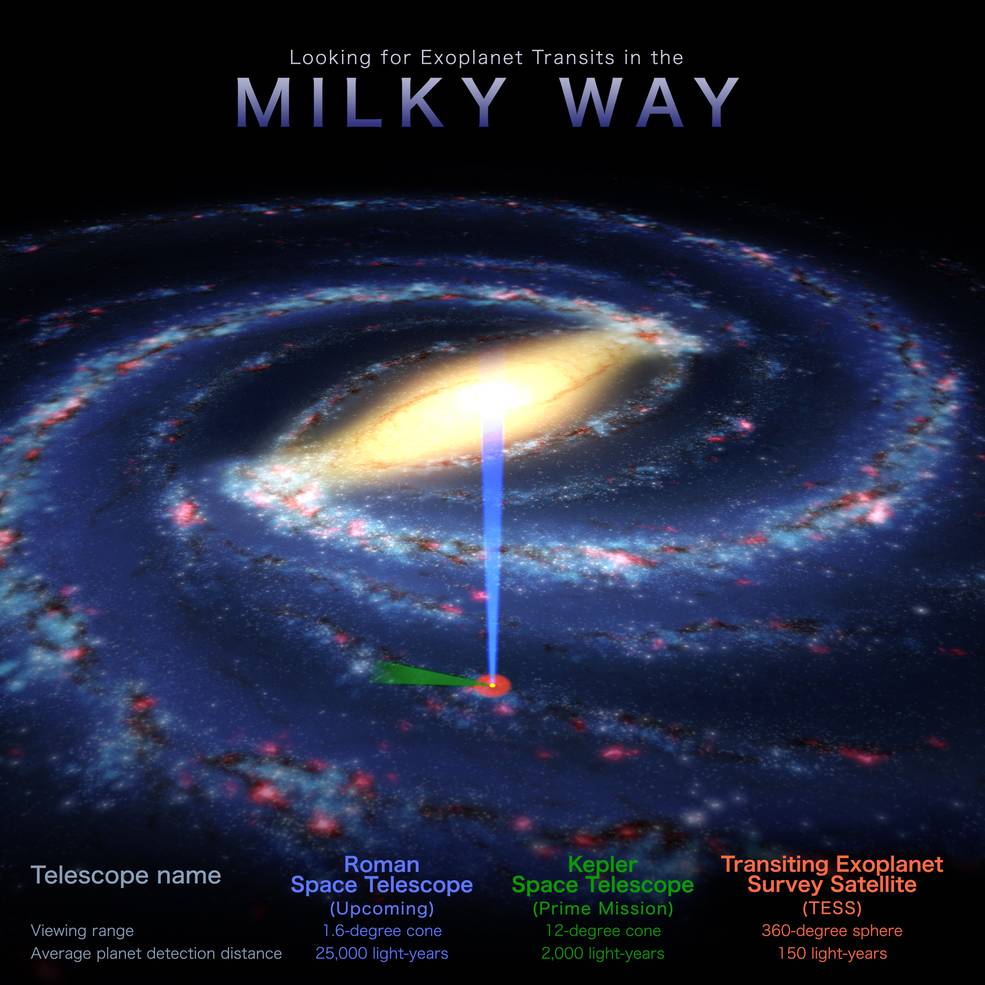Recently we reported on a haul of 2,200 new exoplanets from the 2 year primary mission of the Transiting Exoplanet Survey Satellite (TESS). But that is just the tip of the iceberg in terms of exoplanet hunting. If calculations from NASA are correct the Nancy Grace Roman Space Telescope could detect up to 100,000 new exoplanets when it launches in 2025.
There are two ways Roman will look for potential exoplanets. The first is a more traditional method, already used by TESS and Kepler, to watch for the faiting dimming of a star that happens when a planet passes in front of it. This technique, known as transiting, is the process that has found the bulk of exoplanets so far.
Roman will have much more sensitive systems than any currently launched transiting exoplanet satellite so far. That sensitivity will allow it to detect worlds much farther away than TESS and similar satellites. Exoplanets found by TESS are generally located approximately 150 light years away while Kepler focused on a specific path of sky up to about 2,000 light years away. While it’s nice to collect data on our galactic neighborhood, there are a relatively small number of stars there. Roman, on the other hand, will be sensitive enough to detect planet candidates up to 26,000 light years away, reaching almost all the way to the center of the galaxy.
But it won’t be able to reach that far using the transiting technique alone. It will also rely on a much more novel technique for exoplanet hunting – microlensing. Microlensing itself has been around for some time, and results in some absolutely spectacular astronomical images, such as the “Molten Ring” discovered not long ago. The technique uses a principle of the theory of relativity to take advantage of the fact that light can bend around massive objects, such as a star.
When Roman finds a pair of stars that create a lensing effect, it will be able to detect slight changes in both the stars in the system, allowing it to see transits in stars that are much farther away than would otherwise be possible. Additionally, lensing would add the unique ability to potentially detect planets that are transiting on the opposite site of a star doing the lensing. Any planets found via this technique would dim the light from the star being microlensed, but only because it is blocking that light before it reaches the gravitational pull of the star nearer to Earth the planet is orbiting.
This microlensing technique might also be helpful in finding another type of exoplanet. Known as “rogue planets”, these are not gravitationally bound to a star. Scientists have seen them in the past, but usually only when they are newly formed and emitting infrared radiation. Roman has the potential to see hundreds more of these wanderers, helping to flesh out their formation process and evolution.

Credit: NASA’s Goddard Space Flight Center
Rogue planets will likely only make up a small percentage of the total number of planets detected though. A paper was released a few years ago discussing the two techniques and how they might be used. That paper points out how Roman (then called WFIRST), combined with the (hopefully) soon-to-be-launched James Webb Space Telescope, will bring all new observational capabilities online and really step up the search for extrasolar planets. With luck, in the next decade or so, the planetary science community will have a cornucopia of new potential candidates to look into.
Learn More:
NASA – NASA’s Roman Mission Predicted to Find 100,000 Transiting Planets
The Cosmic Companion – Could the Nancy Grace Roman Telescope Find 100,000 Planets?
digitaltrends – Upcoming Roman Space Telescope could discover 100,000 new exoplanets
UT – Nancy Grace Roman Space Telescope Could Get A Starshade Of Its Own
UT – There Could Be More Rogue Planets Than Stars in the Milky Way. Here’s How Nancy Grace Will Find Them
Lead Image:
Artist’s conception of a planetary transit.
Credit: JPL

